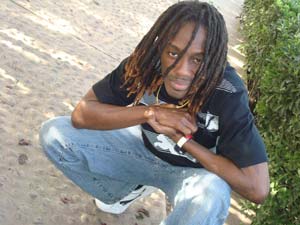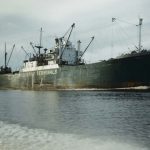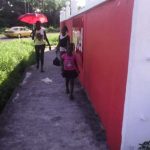I gulped in great puffs of almost blissful air made more refreshing with the scent of fresh green leaves, tropical flowers and that heady but pleasant scent that wafers up from the soil as it braves the scorch of the tropical sun.

I looked out of the bus window and marvelled at the lush greenery on both sides as it flew by in a blur made more arresting with the fusion of white sandy hills and mystical valleys.
Soon we were winding in out and out of dreamy hills, on a twisting road that spiralled upwards on breath-taking highways, before floating down like elated swans through valleys that sported natural waterways, alluring alleyways and paths that disappeared amongst a lush setting of brilliant tree species.
I was headed to the mining town of Linden, and trust me folks I was more than enjoying the luxurious ride. Well that is if I am to avoid mentioning the ‘hair-raising speed’ at which the minibus driver was making his way there.

At times I was sorely tempted to object, but over time I have learnt to be less vocal in such instances since the silly people aboard these buses are known to ‘jump down yuh throat,’ if you should try to admonish drivers for their reckless speeding.
Then we were rolling into the makings of Linden and I marvelled at the still somewhat ‘yester-year beauty’ of the mining town.
What I liked instantly is that there seemed to be enough police presence there and I noted this as a plus for residents.
As we drove around in some areas I could see a few cattle, horses and sheep as they tried to get their fill of the grass that was not so much thriving in this town.
This town however in some ways still bore startling resemblance of locations in the countryside, as was evident with the cows that still made the asphalt or red brick roads their beds and toilet.
This place was striking I had to agree, but the community had seen better times though. Some houses were in serious disrepair but some were still managing to maintain their homes to a reasonable degree.

But one thing that certainly stayed affixed to my imaginative mind was a vivid recount of my journey. I kept reminiscing on the seemingly endless miles of straight road bounded by hills of white, beach-quality sand and emerald jungle. The hills were moderately high with the exception of Moblissa Hill which rose quite sharply. Small Amerindian villages, active sand pits and even a few campsites and glistening black-water creeks.
I had been certainly taken back with the picturesque view what was called Linmine (the bauxite company that belched smoke high above the town.
Linden is a progressive town built exclusively on the back of the once thriving bauxite industry. But when demand for this major export declined so too did the community and it still shows in a few places.

The town is still busy but for me in an idle sort of a way.
Linden is the second largest town in Guyana after Georgetown, and capital of the Upper Demerara-Berbice region, located at 6°0?0?N 58°18?0?W / 6°N 58.3°W / 6; -58.3, altitude 48 metres (160 feet). It was declared a town in 1970, and includes the communities of MacKenzie and Wismar. It lies on the Demerara River and has a population of close to 80,000.
It is primarily a bauxite mining town, containing many mines 60–90 metres deep, with many other pits now in disuse.
Linden is the largest urban centre in Guyana that does not have a university, since the University of Guyana is located in Turkeyen, which is part of Greater Georgetown. The mining company runs a colonial-era guest house, with other hotels including the Summit Hotel, Starbonnet Hotel, and a few others.
Schools in Linden include Mackenzie High School, established in 1946 and similar institutions located at Wismar. Snaking silently and bisecting the town into two, is the

Mackenzie River.
Linden in times gone by
Speaking to Lindener, Jermaine Mc Bean I was informed that today there are just too many sellers and very few buyers. He opined that although the infrastructure had taken a beating, there seemed to be a sense of hope that brighter days would return for residents.
But there is still laughter and merrying at every corner.
Mc Bean noted that, way back in 1996, Vibert, as a young and coming insurance man, was placed in charge of the Linden Branch Office for Hand-In-Hand Insurance Company.
He explained that three villages that made up Linden were previously known as Wismar-MacKenzie-Christianburg, but were renamed/unified in 1970 as a township under the name Linden by then President Linden Forbes Sampson Burnham.
As history would dictate in 1964, Wismar was the site of the Wismar Massacre, where rioting targeted at the Indian minority also led to the widespread destruction of property. The disturbances started on Wednesday May 20, escalating to murder on May 25 before the arrival of British troops on Tuesday May 26. During this period more than two hundred properties were said to be destroyed by fire and more than fifty people reported physical assaults, including at least seven rapes.

The riots also claimed five lives, R. Khan and P. Mirgin, Indian residents of Wismar were killed on May 25, along with G. English, an alleged looter. B. Wharton died in a fire on May 27, while I. Bridgewater was killed on the 28th. The Wismar Massacre decreased the Indian population in Wismar, before the riots it was estimated at 3,000. This fell to about 300 by the following July, as more than 3,000 Indians were evacuated after the riots. The Wismar Massacre was triggered by the general climate of political and ethnic strife within Guyana in 1964. The murder of an African couple in Buxton on May 21 was the most recent violent event, in an extended period of unrest and is considered the trigger for the Wismar Massacre.
On Monday July 6, 1964 an explosion blew apart the Sun Chapman launch as it sailed up the Demerara River from Georgetown to Mackenzie. Forty-three

people of mostly African descent died either due to the explosion or drowned when the launch sank. Most of the thirty-three survivors, including the entire crew, were those fortunate to be on the deck or bow when the boat exploded. The Sun Chapman exploded shortly after leaving Horadia about sixteen miles from Mackenzie.
By July 8, thirty-two bodies were recovered from the river and taken to the Mackenzie Hospital morgue to be buried. Some badly decomposed bodies were also buried at Horadia.
With forty-three fatalities, the sinking of the Sun Chapman is the single largest loss of Guyanese life. Most of the victims were Lindeners travelling home from Georgetown along the Demerara River. The river was commonly used for this journey before the Linden-Soesdyke highway was constructed in 1966.
Today Linden is a fusion of very impressive buildings, businesses and is a location where residents are making efforts to come to grips with many issues and focusing on the positives of modern day.
Banks
Republic Bank Ltd. (Guyana) is located at Republic Avenue, about a 5-minute drive from the Watooka House. Banking Hours are: Mondays to Thursdays from 08:00 hours to 14:00 hours and on Fridays from 08:00 hours to 14:30 hours. ATM service is available 24 hours. Citizens Bank, opened in November 2011 is located on Republic Avenue.
Blue Lake

The origin of the exotic and very popular Blue Lake at Linden dates back to quite a long time. Today this feature is a must have for many and is certainly an icon where the likes of tourism high points are concerned.
Though to be the remains of an old bauxite mine, the lake was, according to locals, immeasurably deep in places and got its color from the sky’s reflection against the white sandy bottom. This very mystical feature is one that ignites awe and amazement from those that are privileged to visit.
Historic Linden
On April 29, 1970, under the Municipal District Council’s Act of 1969, Â Macmarburg, a diminutive for Mackenzie, Wismar and Christianburg was renamed Linden and officially declared a town. Christianburg, the oldest settlement in the town was originally known as Stabroek. It was renamed in honour of Governor Christian Finette, who joined his name with Burg, his wife’s family name. This area was chiefly used for rubber bleeding and saw milling.
The area south of Christianburg was known as ‘Â Shingles Landing,’ on account of the production of shingles and wallaba posts (a local hardwood). Before the discovery of hardwood, this area was an important transit point in gold and diamond mining.

In 1916, with the discovery of bauxite all economic activity in the town was focused on Mackenzie, on the opposite side of the Berbice River.
Today Linden is popularly known as the Mining Town. There are several historical sites scattered throughout this town that are representative of the diversity of Guyana’s heritage.
Places to go while in Linden
While enjoying the serene atmosphere of Watooka, take time out to visit places such as:
• The Mackenzie Museum
• Three Friends, the first bauxite mine in Guyana-
• The Mackenzie Sports Club, the venue of all sporting and culture activities in Linden. It was the home of the first Mashramani, the Kashif & Shanghai Soccer Tournaments and many others.
• See aluminum houses first built in Silver City and Retrieve.
• Take a ride with the river taxi service that is the major means of shopping or visiting between the communities on both sides of the river.
• Look for the now discarded 1300 walking dragline and 1310 bucket wheel excavator, both of which were used to remove over 200 ft. of sand and clay in order to expose our high grade bauxite.

• Take a trip further up the Demerara River by outboard motor launch.
• Visit the 100-year-old Patterson plantation and see the first hydro-power water wheel in Guyana.
• Go shopping at the riverside all-purpose market place.
• Look at the blue water lakes that were created in the mined-out areas.
History of Linden
The communities of Wismar, Christianburg and Mackenzie with a population of over forty thousand residents were granted town status in 1970 and given the name of Linden by popular acclaim. Situated on the west bank of the Demerara River, sixty-five miles from the Georgetown, Wismar and Christianburg were the jump point for balata bleeders, pork knockers and other parties that went into the interior for hunting wild animals and fishing.

Bauxite mining began in 1916 and the dense jungle that is now Mackenzie was transformed into a mining town. In 1915, the official gazette published transport of property from G. B. Mackenzie to Winthrop Cunningham Neilson, a piece of land spelt Watouka, but also known as Watooka. A description of the land goes back to a plan made in April 1829 by Thomas Hubbard, sworn land surveyor. In the transport, it is said that Watooka had been marked as “Ficker” on an old 1829 map.
In the late 1923, the bauxite laboratory was removed from the mining site at Akyma, nine miles away from the present site of Watooka House. In the late 1920s the bauxite laboratory was reconstructed into a house for the manager of the company, C.O. Riggs.
Shortly after the beginning of World War II the demand for aluminum increased tremendously and the company began expanding. Officials from friendly countries, shareholders and industrial customers became regular visitors.
Watooka Guest House
Watooka House was designed and built to accommodate the constant influx of visitors. In the early forties, the existing structure gave way to the present Watooka House. The swimming pool was also completed at that time.
The eastern wing of the first floor was the club for Senior Managers, most of whom were expatriates. The club was a hub for activities, and was the venue for weekly tea parties by wives and functions that included annual Thanksgiving suppers, Halloween parties, New Years’ Eve parties, Cabarets shows and a host of other activities. There was also a tennis court, which was recently converted into a basketball court.
In 1985, the board of the nationalised entity, then Guyana Mining Enterprise Ltd. (Guymine) rehabilitated the building at a cost of $4.5 million dollars. The contractor, Guyconstruct, was instructed to ensure that the old architecture was maintained.
Louis Evans, an employee of Amerindian decent, joined the bauxite company in 1916 and worked for forty five years, insisted to his death that the Watooka name was taken from the creek that runs on the western boundary of the complex. That creek is known as the Watooka Creek.
Following the nationalisation of the bauxite company in 1971, the entire management structure changed and so did the culture of the entity. Dominoes became very popular and snooker gave way to the popular Guyanese game of billiards.
Today, most visitors insist that Watooka House gets better with age, because ‘the older they get, the more they like it.’
Bauxite
According to excerpts taken from the Guyana Guide, the bauxite mines had all manner of ‘niffty’ names like Three Friends, Montgomery, Arrowcane, Akyma, Maria Elizabeth, Ituni, Noitgetdacht, Warabaru, and others.
There were three methods used to remove the overburden to get at the bauxite ore, and those were the Dragline, Wheel Excavator and Water Blasting.
These Draglines were so big that they did not run on tracks. Instead they had feet and moved in a walking fashion. Special roads had to be built to accommodate the size. We were all impressed by the fact that you could drive a Land Rover into the bucket. It wasn’t really the size of the bucket but rather the length of its boom that was the measuring stick for the Draglines. Long booms meant that you could move overburden further.
When the mining was done Mother Nature was left to take over. The mines would fill up with water creating great swimming lakes. For some reason some of the lakes had clear water rather than the tea coloured water of the Demerara River. This apparent cleanliness and the fact that many knew there were no ‘Pirai’ fishes there made for a swimmers paradise.
Tracked shovels were used to load the bauxite ore onto trains for transport to the bauxite plant. At the bauxite plant the ore was crushed, dried and then loaded onto ocean going ships for transport to Arvida via Chaguaramas, Trinidad and Port Alfred, Canada.
In 1961 Demba completed the construction of their Alumina plant in Mackenzie. Bauxite is chemically treated to produce Alumina (Aluminum Oxide). Alumina can then be smelted to produce Aluminum with lots of electricity and thus usually done in places where electricity is cheap.
The first leg of the journey was the Demerara River which was not deep enough to accommodate fully loaded ships.
At MacKenzie the ships were only partially loaded for the run down the shallow Demerara River to Georgetown. At Georgetown they would have to wait for high tide to clear the sand bars at the mouth of the river. It was then on to Chaguaramas, a deep water port in Trinidad where the ships were topped up with bauxite for the transit of the Atlantic Ocean to Canada.
Before ships like the Baron Belhaven, the bauxite was transported by a company called Saguenay Terminals of Montreal. I suspect Alcan chartered these ships. Many of the bauxite ships names started with Sun as in Sun Victor or Sun Brayton.
Upon reaching Canada the bauxite ships had to navigate up the St, Lawrence River and then the Saguenay River to Port Alfred where they were unloaded. The bauxite ore was then moved to Arvida where it was processed into aluminum.
In 1998 the Government of Guyana announced privitisation plans for the state-owned bauxite companies, Berbice Mining Enterprise Limited (BERMIBE) and Linden Mining Enterprise Limited (LINMINE). The companies will each be restructured into new private companies that will be capitalised, majority-owned (sixty percent under the Government’s preferred structure), and operated by a private investor.
On August 5, the Government of Guyana hosted a privatisation seminar for the five companies shortlisted to bid for 60 per cent controlling interests the Linden Mining Enterprise (LINMINE) and Berbice Mining Enterprise (BERMINE), in Georgetown.
Alcoa World Alumina, Billiton, and the consortium of Texas-Ohio Incorporated, Harbisson Walker, Possehl and Morrison Knudsen have bid for control of both BERMINE and LINMINE. Aroaima Mining Company bid for BERMINE, and a consortium of Guyanese and overseas investors, RASC 2000, for LINMINE alone.
Alcoa was involved in a takeover of Reynolds. It is not clear how the takeover will affect Aroaima Mining Company’s bid for BERMINE or their mining operations at Aroaima.
2000 During April 2000, Head of the Privatisation Unit, Winston Brassington, reported that the bid put forward by Aroaima Bauxite Company for the Berbice Mining Enterprise was not acceptable based on the government’s bid evaluation criteria, and the privatization process for the local industry will have to go back to the bidding table. He also stated that there was one proposal for Linmine and Bermine which was rejected.
Chatting with a few
Many were hesitant to converse with the media, but the few that did expressed hope for positives for the people in terms of infrastructural improvement and economic development.
Amongst them was Theresa Fortune of One Mile who was of high praise for the new initiative of government of distributing the monetary incentives for school children in the area.
“There is much room for improvement in our infrastructural front and we could do with a little sprucing up on the economic side, but that aside I must thank the Government for helping out the thousands of students they did through their financial assistance initiative. This has greatly helped many who are experiencing financial difficulties. However I want Government to know that Linden is a really beautiful place and I hope they would invest some time soon in making it one of Guyana’s ideal tourism destinations.”
Housewife, Enid Jackman felt that Linden is indeed the most exotic location in Guyana and opined that much should be done to boost its tourism potential.
“Sir, I am proud to say that Linden is by far one of the loveliest locations in Guyana. Take for instance our endearing hills and valleys. This place is a divine work of Mother Nature. If only the authorities can for one moment focus on this location a little more, and invest wisely in making it a tourism high point, the returns would certainly be bountiful. I am having such crazy ideas of what can be done with this place…..”
Dennis Trotman an engineer spoke on the issue of employment and the establishment of the market at Linden.
“In the days of vibrant bauxite mining at Linden almost everyone had something to do in terms of occupation. However since that has dwindled many are without jobs today. Yes many have reserved to vending and shop keeping and such likes. And others have ventured into the interior in search of gold and such likes…. But there is certainly need for more job opportunities to be created here. There is a market built here and we are thankful for that, but vendors are avoiding the facility because its geographical location does not allow for maximum sales. As such persons prefer to go over to Wismar and make their purchases and those operating inside the Municipal Market are losing out big time…”.
(By Alex Wayne)


.jpg)





























